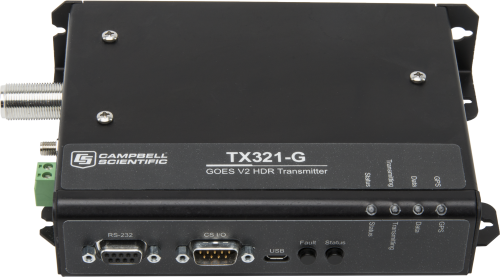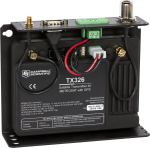This product is no longer available and has been replaced by: TX325. Some accessories, replacement parts, or services may still be available.

| Services Available | |
|---|---|
| Repair | No |
| Calibration | No |
| Free Support | Yes |
Overview
The TX321 is a GOES and Meteosat satellite data transmitter. It provides an easy and reliable way for Campbell Scientific data collection platforms (DCP) to transmit data over geostationary satellites. The TX321 is typically used by government agencies and sponsored research organizations for the purpose of collecting environmental data.
Read MoreBenefits and Features
- GOES High Data Rate Version 2, Meteosat SRD, and International DCS operation
- Very low power consumption when idle (< 5 mA @ 12V)
- Transmissions continue for 28 days if GPS is lost
- Configuration and diagnostics easily performed by data logger or computer
- Drop-in replacement for Campbell Scientific TX320, TX312, and SAT HDR GOES
Images












Technical Description
The TX321 is designed for use on the NOAA GOES Data Collection System and the EUMETSAT Meteosat Data Collection Services satellite networks. These networks use geostationary satellites and ground stations to receive and relay data transmitted from remote data collection platforms (DCP), such as those provided by Campbell Scientific. These DCPs are typically owned and operated by government agencies and sponsored research organizations. Users are given a frequency and time slot for their transmissions.
Data Collection Platform (DCP) Equipment
- TX321 Satellite Transmitter
- 17992 or 31182 GPS antenna and their antenna mounts and coaxial cables
- 25316 11 dBi Right-Hand Circular Polarized (RHCP) Yagi antenna and coaxial cable
- Data logger
- Power supply, such as Campbell Scientific’s BP12 or BP24 battery, CH150 or CH200 charge regulator, and SP10 10 W or SP20 20 W solar panel
GOES System Authorization Procedure
Non-U. S. government agencies and research organizations must have a sponsor from a U.S. government agency. Prospective GOES users must receive formal permission from NESDIS, by doing the following:
- Fill out the System Use Agreement (SUA) application form. The form can be submitted online or sent to:
GOES DCS SUA Processing Unit NOAA,
Satellite Services Division
4231 Suitland Road, Rm 1646
Suitland Federal Center Suitland, MD 20746
Tel: 301-817-4563
Fax: 301-817-4569
Email: Letecia.Reeves@noaa.gov - Following approval, NESDIS sends a Memorandum of Agreement (MOA). The MOA must be signed and returned to NESDIS.
- After the MOA is approved, NESDIS will issue a channel assignment and an ID address code.
- NESDIS must be contacted to coordinate a start-up date.
Meteosat System Authorization Procedure
Complete and submit the EUMETSAT DCP Admission form.
Specifications
| Transmission Distance or Area |
|
| Transmissions Supported |
|
| Transmit RF Out Connector | Type N jack |
| Radio Module | G6 OEM |
| Operating Temperature Range | -40° to +60°C |
| Storage Temperature Range | -55° to +70°C |
| Case Dimensions | 18.54 x 12.7 x 3.81 cm (7.3 x 5 x 1.5 in.) |
| Maximum Dimensions | 20.96 x 13.34 x 4.06 cm (8.25 x 5.25 x 1.6 in.) including connectors |
| Weight | 0.77 kg (1.7 lb) |
Supply Power |
|
| Supply Voltage | 10.8 to 16 Vdc |
| Typical Current Drain |
|
| Connector | Removable 2 pin screw terminal, 5 mm pitch |
Satellite GOES |
|
| Standards | NOAA/NESDIS GOES High Data Rate Certification Standards version 2 |
| Baud Rates | 300 and 1200 bps |
| Transmit Power |
|
| Frequency Range | 401.701 to 402.0985 MHz |
| Initial Frequency Stability | ±20 Hz disciplined to GPS (GPS fix occurs after power up and once per day thereafter.) |
| Channel Bandwidth |
|
Satellite Meteosat |
|
| Operation | EUMETSAT Meteosat SRD |
| Baud Rates | 100 bps |
| Transmit Power |
|
| Frequency Range | 402.0355 to 402.4345 MHz |
| Initial Frequency Stability | ±20 Hz disciplined to GPS (GPS fix occurs after power up and once per day thereafter.) |
| Channel Bandwidth | 3 kHz (100 bps) |
GPS Receiver |
|
| Receiver Type | 3.3 V active |
| Connector | SMA jack |
Timekeeping |
|
| Initial Accuracy | ±100 μs (synchronized to GPS) |
| Drift | ±10 ms/day (without GPS) |
| GPS Schedule | 1 fix at power up (1 fix per day afterwards) |
| Transmission Continuation without GPS Fix | 28 days |
Interface Connectors |
|
| USB | Micro B, USB device |
| RS-232 | DB9 F, DCE, 3 wire RS-232 |
| CS I/O | DB9 M, SDC 4 |
| Satellite RF Transmit Out | Type N jack |
| GPS | SMA jack |
| Power | Removable 2 pin |
Interface Command Protocols |
|
| Binary Command Protocol |
|
| ASCII Command Protocol | Available on all ports |
25316 Transmit Antenna |
|
| Gain | 11 dBi |
| Antenna Type | Right-hand circular polarization Yagi |
| Connector | Type N female |
| Wind Load | ~100 knots |
17992 GPS Antenna |
|
| Antenna Type | 3.3 V active dome, pipe mount |
| Gain | 28 dBi |
| Connector | TNC jack |
31182 GPS Antenna |
|
| Antenna Type | 3.3 V active patch, magnetic mount |
| Gain | 27 dBi |
| Connector | SMA plug |
Compatibility
Please note: The following shows notable compatibility information. It is not a comprehensive list of all compatible products.
Dataloggers
| Product | Compatible | Note |
|---|---|---|
| CR1000 (retired) | ||
| CR200X (retired) | ||
| CR216X (retired) | ||
| CR300 | The CR300 requires a null modem cable, pn 18663. | |
| CR3000 | ||
| CR310 | The CR310 requires a null modem cable, pn 18663. | |
| CR5000 (retired) | ||
| CR6 | ||
| CR800 (retired) | ||
| CR850 (retired) | ||
| CR9000X (retired) |
Mounting Equipment
| Product | Compatible | Note |
|---|---|---|
| ENC10/12 | ||
| ENC12/14 | When installing the TX321 into the ENC12/14, it must be mounted flat or a right-angle serial connector must be used, such as that offered by the SC12 or a ribbon cable. | |
| ENC14/16 | When installing the TX321 into the ENC14/16, it must be mounted flat or a right-angle serial connector must be used, such as that offered by the SC12 or a ribbon cable. | |
| ENC16/18 |
Additional Compatibility Information
Power Supply
Typical power supply is a BP12 12 Ahr or BP24 24 Ahr battery, CH150 or CH200 regulator, and an SP10 or SP20 solar panel. The BP85 or a user-supplied deep-cycle rechargeable battery can be used if the system contains higher power consumptive devices such as continuous bubblers or heated rain gages.
Note: Because of the peak power draw during transmit, do not connect to the 12V output of a data logger.
Resources and Links
Product Brochures
Downloads
TX321 / TX320 GPS Update v.4 (1.09 MB) 18-12-2019
This download is a zip file that contains new firmware v11.11 and v10.23 for the G6 radio internal to the TX321 and v8.04 for the G5 radio internal to the TX320.
The file also contains the software package that uploads the new firmware and the TX321 / TX320 firmware update procedure.
TX320 & TX321 USB Drivers v.2.08.28 (1.64 MB) 05-03-2013
TX320 & TX321 USB Drivers for the Windows operating system. 32 and 64 bit support for Windows 8, Windows 7, Windows Vista and Windows XP.
Note: Drivers should be loaded before plugging the TX320 or TX321 into the computer.
Case Studies
Introduction The Andes Mountains of Argentina are home to a rich and diverse group of organic......read more
Articles and Press Releases
Newsletter Articles
Privacy Policy Update
We've updated our privacy policy. Learn More
Cookie Consent
Update your cookie preferences. Update Cookie Preferences

